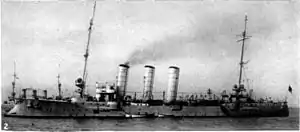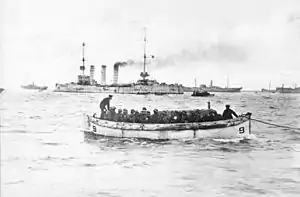SMS Danzig
SMS Danzig[lower-alpha 1] was a light cruiser of the Imperial German Navy. Named for the city of Danzig (now Gdańsk, Poland), she was the seventh and last ship of the Bremen class. She was begun by the Imperial Dockyard in her namesake city in 1904, launched on 23 September 1905 and commissioned on 1 December 1907. Armed with a main battery of ten 10.5 cm (4.1 in) guns and two 45 cm (18 in) torpedo tubes, Danzig was capable of a top speed of 22 knots (41 km/h; 25 mph).
 An unidentified Bremen-class cruiser | |
| History | |
|---|---|
| Name: | Danzig |
| Laid down: | 1904 |
| Launched: | 23 September 1905 |
| Commissioned: | 1 December 1907 |
| Stricken: | 5 November 1919 |
| Fate: | Scrapped, 1922–1923 |
| General characteristics | |
| Class and type: | Bremen-class light cruiser |
| Displacement: | |
| Length: | Length overall: 111.1 meters (365 ft) |
| Beam: | 13.3 m (43.6 ft) |
| Draft: | 5.68 m (18.6 ft) |
| Installed power: |
|
| Propulsion: | |
| Speed: | 22 knots (41 km/h; 25 mph) |
| Range: | 4,690 nmi (8,690 km; 5,400 mi) at 12 kn (22 km/h; 14 mph) |
| Complement: |
|
| Armament: |
|
| Armor: |
|
Danzig spent the first ten years of her career in the reconnaissance forces of the High Seas Fleet. The ship saw extensive service during the First World War; she was present at the Battle of Heligoland Bight in August 1914, but did not engage British warships. She also saw action in the Baltic Sea against Russian forces, and was badly damaged by a Russian mine in November 1915. Danzig was also involved in Operation Albion, the seizure of the islands at the entrance of the Gulf of Riga, in September 1917. She was thereafter withdrawn from service, and surrendered to Britain after the end of the war as a war prize. Danzig was dismantled for scrap starting in 1921.
Design
The German 1898 Naval Law called for the replacement of the fleet's older cruising vessels—steam corvettes, unprotected cruisers, and avisos—with modern light cruisers. The first tranche of vessels to fulfill this requirement, the Gazelle class, were designed to serve both as fleet scouts and as station ships in Germany's colonial empire. They provided the basis for subsequent designs, beginning with the Bremen class that was designed in 1901–1903. The principle improvements consisted of a larger hull that allowed for an additional pair of boilers and a higher top speed.[1][2]
Danzig was 111.1 meters (365 ft) long overall and had a beam of 13.3 m (44 ft) and a draft of 5.68 m (18.6 ft) forward. She displaced 3,278 metric tons (3,226 long tons) as designed and up to 3,783 t (3,723 long tons) at full load. Her propulsion system consisted of two triple-expansion steam engines with steam provided by ten coal-fired Marine-type water-tube boilers. Her propulsion system was rated at 10,000 metric horsepower (9,900 ihp) for a top speed of 22 knots (41 km/h; 25 mph). Danzig carried up to 860 t (850 long tons) of coal, which gave her a range of 4,690 nautical miles (8,690 km; 5,400 mi) at 12 knots (22 km/h; 14 mph). She had a crew of 14 officers and 274–287 enlisted men.[3]
The ship was armed with ten 10.5 cm (4.1 in) SK L/40 guns in single mounts. Two were placed side by side forward on the forecastle, six were located amidships, three on either side, and two were placed side by side aft. The guns could engage targets out to 12,200 m (13,300 yd). They were supplied with 1,500 rounds of ammunition, for 150 shells per gun. For defense against torpedo boats, she carried ten 3.7 cm (1.5 in) Maxim guns in individual mounts. She was also equipped with two 45 cm (17.7 in) torpedo tubes with five torpedoes. They were submerged in the hull on the broadside. Danzig was also fitted to carry fifty naval mines. The ship was protected by an armored deck that was up to 80 mm (3.1 in) thick. The conning tower had 100 mm (3.9 in) thick sides, and the guns were protected by 50 mm (2 in) thick gun shields.[3][4]
Service history
Danzig was ordered under the contract name Ersatz Alexandrine[lower-alpha 2] and was laid down at the Imperial Dockyard in Danzig in 1904 and launched on 23 September 1905, after which fitting-out work commenced. She was commissioned into the High Seas Fleet on 1 December 1907. After her commissioning, Danzig served in the reconnaissance forces of the High Seas Fleet. In 1910, she was used as a training ship for the fleet's gunners.[5]
She returned to fleet service in August 1914 after the outbreak of World War I.[6] She was moored in Brunsbüttel with her sister-ship München, en route to Kiel via the Kaiser Wilhelm Canal on the morning of 28 August 1914, when the British attacked the German patrol line in the Heligoland Bight. During the ensuing Battle of Heligoland Bight, Danzig and München were recalled and ordered to steam to the mouth of the Elbe and wait for further orders. Danzig reached the stricken cruiser Ariadne shortly before 15:00 and lowered boats to rescue survivors. Konteradmiral Franz von Hipper, the commander of the I Scouting Group, issued an order for all cruisers to regroup on the approaching battlecruisers Von der Tann and Moltke, but Fregattenkapitän Reiß, Danzig's commander, refused, replying that he was "Rescuing people from Ariadne."[7]

On 7 May 1915, the IV Scouting Group, which by then consisted of Danzig, München, Stettin, and Stuttgart, and twenty-one torpedo boats was sent into the Baltic Sea to support a major operation against Russian positions at Libau. The operation was commanded by Rear Admiral Hopman, the commander of the reconnaissance forces in the Baltic. The IV Scouting Group was tasked with screening to the north to prevent any Russian naval forces from moving out of the Gulf of Finland undetected, while several armored cruisers and other warships bombarded the port. The Russians did attempt to intervene with a force of four cruisers: Admiral Makarov, Bayan, Oleg, and Bogatyr. The Russian ships briefly engaged München, but both sides were unsure of the others' strength, and so both disengaged. Shortly after the bombardment, Libau was captured by the advancing German army, and Stettin and the rest of the IV Scouting Group were recalled to the High Seas Fleet. On 8 May, Danzig joined the old pre-dreadnought battleships of the IV Battle Squadron on a reconnaissance toward Gotland; the operation lasted until 10 May, but encountered no Russian forces. Danzig ran into a Russian minefield on the evening of 25 November 1915, and was badly damaged by one of the mines.[8] She was towed back to port, however, and repaired.[9]
In early September 1917, following the German conquest of the Russian port of Riga, the German navy decided to eliminate the Russian naval forces that still held the Gulf of Riga. The Admiralstab (the Navy High Command) planned an operation to seize the Baltic island of Ösel, and specifically the Russian gun batteries on the Sworbe Peninsula. On 18 September, the order was issued for a joint operation with the army to capture Ösel and Moon Islands; the primary naval component was to comprise the flagship, Moltke, along with the III and IV Battle Squadrons of the High Seas Fleet. The invasion force amounted to approximately 24,600 officers and enlisted men.[10] Danzig had by this time been transferred to the II Scouting Group, which was tasked with screening for the invasion force. During the operation, Prince Adalbert, Kaiser Wilhelm II's son, was the ship's commander. Danzig's only significant action during the operation came on the 19th, when she and Königsberg and Nürnberg were sent to intercept two Russian torpedo boats reported to be in the area. The Germans could not locate the vessels, and broke off the operation.[11]
Danzig was withdrawn from active service in late 1917. She survived the end of the war, and was stricken from the naval register on 5 November 1919. The ship was surrendered to the United Kingdom as the war prize R on 15 September 1920, and broken up for scrap in Whitby in 1921–1922.[6]
Notes
Footnotes
- "SMS" stands for "Seiner Majestät Schiff" (German: His Majesty's Ship).
- German warships were ordered under provisional names. For new additions to the fleet, they were given a single letter; for those ships intended to replace older or lost vessels, they were ordered as "Ersatz (name of the ship to be replaced)".
Citations
- Hildebrand, Röhr, & Steinmetz, p. 124.
- Nottelmann, pp. 108–110.
- Gröner, pp. 102–103.
- Hildebrand, Röhr, & Steinmetz, p. 217.
- Gröner, pp. 102–104.
- Gröner, p. 104.
- Staff 2011, pp. 13, 24, 26.
- Halpern, pp. 191–193, 205.
- Herwig, p. 206.
- Halpern, pp. 213–215.
- Staff 2008, pp. 4, 140, 152.
References
- Gröner, Erich (1990). German Warships: 1815–1945. Vol. I: Major Surface Vessels. Annapolis: Naval Institute Press. ISBN 978-0-87021-790-6.
- Halpern, Paul G. (1991). A Naval History of World War I. Annapolis: Naval Institute Press. ISBN 978-1557503527.
- Herwig, Holger (1980). "Luxury" Fleet: The Imperial German Navy 1888–1918. Amherst: Humanity Books. ISBN 978-1-57392-286-9.
- Hildebrand, Hans H.; Röhr, Albert & Steinmetz, Hans-Otto (1993). Die Deutschen Kriegsschiffe: Biographien: ein Spiegel der Marinegeschichte von 1815 bis zur Gegenwart (Band 2) [The German Warships: Biographies: A Reflection of Naval History from 1815 to the Present (Vol. 2)] (in German). Ratingen: Mundus Verlag. ISBN 978-3-8364-9743-5.
- Nottelmann, Dirk (2020). "The Development of the Small Cruiser in the Imperial German Navy". In Jordan, John (ed.). Warship 2020. Oxford: Osprey. pp. 102–118. ISBN 978-1-4728-4071-4.
- Staff, Gary (2008). Battle for the Baltic Islands. Barnsley: Pen & Sword Maritime. ISBN 978-1-84415-787-7.
- Staff, Gary (2011). Battle on the Seven Seas. Barnsley: Pen & Sword Maritime. ISBN 978-1-84884-182-6.